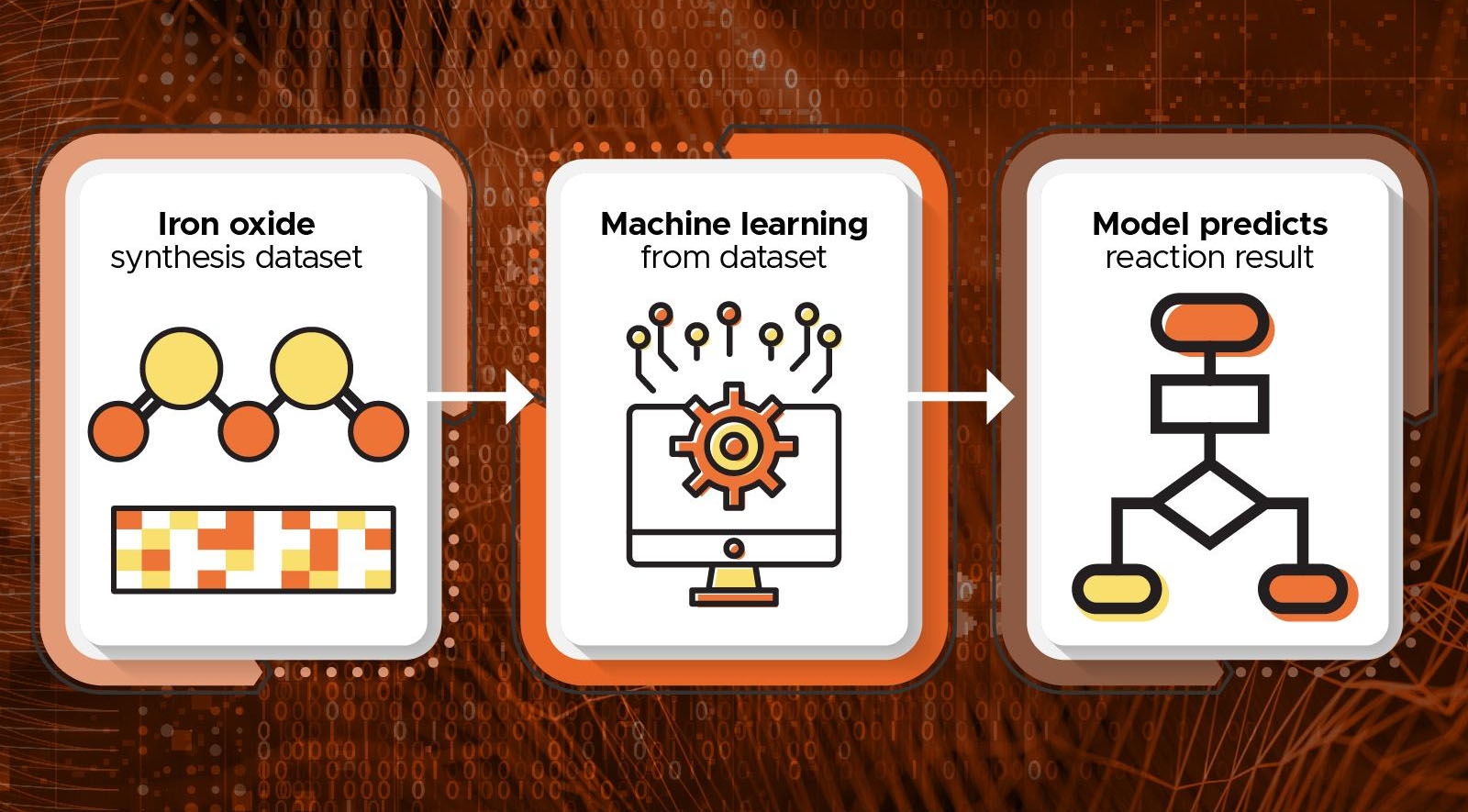| Feb 13, 2024 | |
Machine learning enables more directed synthesis of specialized nanoparticles |
|
| (Nanowerk Spotlight) The unique properties of iron oxide nanoparticles hold remarkable potential for applications in areas like energy storage, biomedicine, and catalysis. However, researchers have faced enduring difficulties in achieving reliable control over critical traits such as particle size and crystalline phase during synthesis procedures. The intricate sensitivities involved make directing the formation of these nanomaterials an obstinate challenge, traditionally relying heavily on trial-and-error experimentation. | |
| Now, scientists at Pacific Northwest National Laboratory (PNNL) have developed an artificial intelligence approach utilizing machine learning that can accurately forecast experimental outcomes and recommend parameters to obtain iron oxides with user-defined specifications. Their models and algorithms provide solutions to two central obstacles that have long impeded progress in materials synthesis: predicting results from defined conditions and uncovering ideal recipes to yield intended nanoparticles. | |
| The findings have been published in Chemical Engineering Journal ("Machine learning assisted phase and size-controlled synthesis of iron oxides"). | |
 |
|
| A machine learning model can predict potential outcomes for different reaction conditions in the synthesis of iron oxide particles. (Image: Xin Zhang and Stephanie King | Pacific Northwest National Laboratory) | |
| While properties like electrical conductivity and catalytic activity depend profoundly on size and crystalline structure, traditional synthesis methods struggle with intricate complexities that make particle formation difficult to direct. Machine learning offers a way forward by detecting patterns between ingredients and resulting traits. | |
| The PNNL group compiled a dataset pooling prior work and their own tests, covering factors like temperature, pH, reagents, concentration, and reaction time alongside measured quantities such as phase and diameter. They trained models on four algorithms - random forest, logistic regression, support vector machine, and k-nearest neighbor - to correlate preparation to production. During cross-validation, random forest achieved outstanding 96% and 81% accuracy at predicting phase and size, respectively. | |
| Further analysis revealed the models latch onto known importance features, namely precursor amount, acidity, heat, and duration. Additional experiments validated the robustness of predictions on unseen conditions. | |
| Moreover, the team programmed an algorithm that ranks parameter sets based on similarity to past successes in yielding a desired output. This facilitates targeted screening of literature rather than blanket searches. It also complements the predictive capacity - if models foresee a high chance of success, the synthesis can be carried out and contribute data back to the dataset after characterization. | |
| The overall framework propels more directed, rapid advancement through such closed-loop feedback between in silico guidance and empirical adjustment. | |
| By wresting substantial control over end properties away from pure luck, machine learning slashes the need for drawn-out trials on every subtle variation. Dr. Xin Zhang, lead author from PNNL, remarked “the predictions of product phase and particle size from the models are in good agreement with the experimental results.” Co-author Dr. Kevin Rosso added their study “lays the foundation for a closed-loop approach in materials synthesis and preparation, from suggesting potential reaction parameters from the dataset and predicting potential outcomes, through conducting experiments and analysis, to enriching the dataset.” | |
| Looking forward, the integration of artificial intelligence and autonomous optimization with nanoscale fabrication could accelerate discovery and refinement of precisely tailored iron oxides for emerging technologies. | |
| According to Dr. Emily Saldanha, co-author from PNNL, “this material is based upon work supported by the U.S. Department of Energy, Office of Science, Office of Basic Energy Sciences, Chemical Sciences, Geosciences, and Biosciences Division through its Geosciences program at Pacific Northwest National Laboratory.” | |
| The research exemplifies the symbiosis of computing and lab science overcoming intrinsic impediments to next generation particles and processes. With increasing datasets and continual accumulation of models' wisdom, what once seemed almost impenetrable complexity is resolving into clarity and control. | |
 By
Michael
Berger
– Michael is author of three books by the Royal Society of Chemistry:
Nano-Society: Pushing the Boundaries of Technology,
Nanotechnology: The Future is Tiny, and
Nanoengineering: The Skills and Tools Making Technology Invisible
Copyright ©
Nanowerk LLC
By
Michael
Berger
– Michael is author of three books by the Royal Society of Chemistry:
Nano-Society: Pushing the Boundaries of Technology,
Nanotechnology: The Future is Tiny, and
Nanoengineering: The Skills and Tools Making Technology Invisible
Copyright ©
Nanowerk LLC
|
|
|
Become a Spotlight guest author! Join our large and growing group of guest contributors. Have you just published a scientific paper or have other exciting developments to share with the nanotechnology community? Here is how to publish on nanowerk.com. |
|
